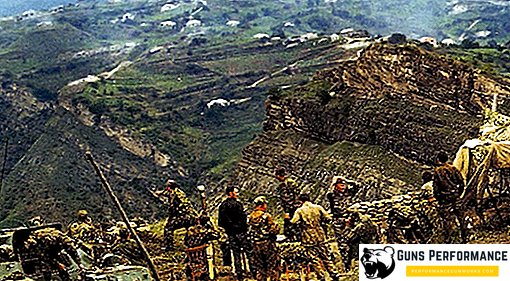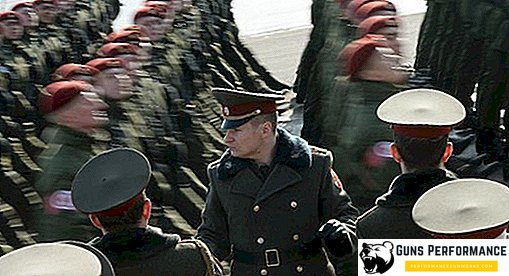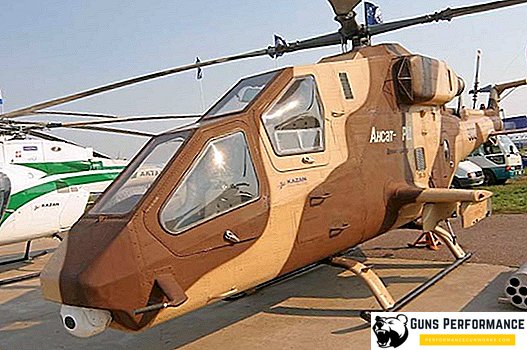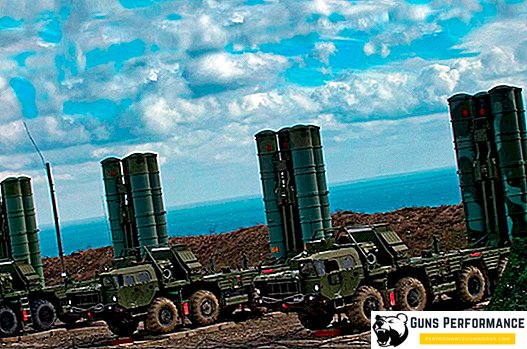The first-born of the fourth generation of Soviet aircraft was the supersonic two-seater interceptor MiG-31. The plane, which was born more than a quarter of a century ago, still retains a palm in speed and in flight altitude.
The main distinctive feature of this combat vehicle is that until the end of the nineties it remained the only fighter on which the on-board radio relay station was installed, which has a phased antenna array (PAR). Moreover, the ability to use long-range air-to-air missiles, which characterizes this Russian aircraft, is only available for the American F-14 carrier-based fighter.

Technical characteristics of the 1980 MiG-31
- Years of production: 1975-1994.
- Total manufactured: about 500 pcs.
- Combat use: military conflicts of the late XX - early XXI centuries.
- Crew - 2 people.
- Take-off weight - 46.75 tons.
- Dimensions: length - 21.6 m, height 6.5 m, wing span - 13.4 m.
- Armament: 23-mm cannon, ammunition load of 260 shells, six suspension points on which air-to-air missiles are mounted.
- Turbojet engine.
- The maximum speed is 3000 km / h.
- Practical ceiling - 20.6 km.
- Flight range - 5400 km.
Photo MiG-31


Modifications of the MiG-31
The prototype of the aircraft, which appeared in 1975, had the marking E-155MP. Repeatedly carried out modernization of the MiG-31 led to the fact that the light came the following modifications:
- MiG-31B, equipped with a system that allowed to make refueling in the air;
- MiG-31BM, which is a multipurpose fighter designed to combat radar;
- MiG-31D experimental version capable of launching an anti-satellite missile;
- MiG-31M, with enhanced weapons, avionics, radar.
This aircraft had other modifications that were design and research, as well as modifications intended for export.
Aircraft combat use
The MiG-31 is a further development of the MiG-25P, which was also an interceptor fighter. The characteristics possessed by the MiG-31 and its engine allow it at any time, day or night, under any weather conditions and even in conditions of intense electronic warfare:
- perform long patrol missions;
- fight aerodynamic targets of all classes, including:
- small cruise missiles;
- helicopters;
- high-altitude high-speed aircraft;
- bombers.
The MiG-31 interceptor fighter is the only aircraft whose characteristics enable it to intercept and destroy cruise missiles flying at extremely low altitude.

A bit of history
When creating the aircraft, the drawings of which were developed at the Mikoyan design bureau since 1972, the following characteristics were identified as the target:
- maximum interception range - 700 km;
- cruising speed - 2 500 km / h, which is 2.35 times the speed of sound;
- subsonic speed - 1,200 km / h.
The prototype was built in 1975, and on September 16 of the same year, it passed its first tests. After the release of the installation batch, some technical modifications were made, and since 1979, the serial production of the machine began under its final name MiG-31.
Technical features fighter-interceptor
In contrast to the MiG-25P, which was the source for the new car, the MiG-31 cabin was designed for a crew of two people, since the complexity of the installed radio equipment required an additional person — a navigator-operator who was assigned the following main tasks:
- airspace control;
- development of tactical techniques to intercept group targets.
The aircraft’s armament was enhanced by the use of the Zaslon radar, which was an important part of the avionics.

The first combat use of the phased array (phased array antenna), which was a novelty in the field of radio electronics, took place in 1978, when during the flight, a detection was made and 10 flying targets were simultaneously followed.
In 1998, the Russian MiG-31BM was demonstrated to specialists, the armament and equipment of which makes it possible to combat radars.
So far, no analogues of the MiG-31 have been created abroad.
Design characteristics of the MiG-31
The design of the aircraft, the drawings of which largely coincide with the MiG-25, is characterized by the following features:
- scheme - normal aerodynamic;
- wing - trapezoidal high;
- stabilizer - all-turning;
- plumage - two-fin.
The technical characteristics of the MiG-31 are largely determined by the materials used to manufacture its airframe. In particular, half of the body is made of stainless steel, 33% of aluminum alloys, 16% of titanium. Aluminum alloys are interesting in that their working temperature can reach 150 °. In the same places that are subject to high kinetic heating, caused by supersonic speed, stainless steel and titanium parts are installed. Such a successful selection of materials allowed to minimize the mass of the aircraft glider.

An important advantage that this Russian interceptor fighter possesses is its ability to take off from ice and unpaved airfields, which is of particular importance when operating in underdeveloped Siberian regions.
Aircraft engine
The D-30F6 engine mounted on a combat vehicle is a dual circuit, in which the turbine mixes internal and external circuits behind the turbine. The engine is equipped with an afterburner chamber and an all-mode adjustable nozzle having a folding design. In total, the aircraft has two engines, each of which is characterized by the following main parameters:
- maximum unformed traction - 9 270 kgf;
- maximum afterburner - 15 510 kgf;
- dry weight - 2 420 kg.
Each engine has side air intakes of rectangular cross section, adjustable by means of horizontal movable panels.
The stock of fuel placed on board the aircraft is 1,630 kg. It is distributed between 7 fuselage, 5 wing and 2 keel tanks. On the underwing nodes, 2 additional tanks of 2,500 liters each can also be suspended. Refueling of all tanks is centralized.

The MiG-31 fighter-interceptor is also interesting in the presence of an in-flight refueling system. This operation is carried out with the help of aircraft tankers Su-24T and IL-78, the hose from which is connected to the extendable L-shaped rod of the fuel receiver.
MiG-31 equipment
The equipment that the aircraft has on board allows it to be used:
- offline;
- in the group consisting of the same type of aircraft;
- as a leader in ensuring the control of fighters with less sophisticated avionics.
The radar installed on the aircraft, has the following main characteristics:
- maximum target detection range - 200 km;
- target tracking distance is 120 km.
Thanks to the capabilities of the radar, aircraft armament can hit targets in the upper hemisphere, and against the background of the earth. Up to 10 targets can be simultaneously on automatic tracking. The Argon-K calculator, located on board, chooses from among them 4 of the most significant, to which 4 P-33 missiles are simultaneously directed.

The MiG-31 also has an 8TP heat finder onboard, the maximum detection range of which reaches 50 km. The presence of this device ensures the detection of targets even in the conditions of high-intensity electronic noise.
Maximum combat effectiveness is guaranteed by the interaction of four MiG-31s, united through an ACS in a single combat system. The information exchange capabilities provided by the aircraft’s equipment allow it to be used for the long-range detection of targets and for targeting such combat vehicles as the MiG-29 and Su-27 to them.
The operator’s cabin is equipped with a large-format tactical situation indicator and navigation equipment consisting of the Route and Tropik radio navigation systems. On the windshield of the cockpit there is a colored indicator PPI-70V, which provides the pilot with comprehensive information in the form of colored inscriptions, benchmarks, indices and scales. Analogues of this indicator abroad do not exist until now.

Aircraft armament
The armament of an interceptor fighter includes:
- long-range guided missiles R-33;
- medium-range guided missiles R-40T;
- guided missiles R-73, R-60M or R-60 short range;
- six-barreled gun GSH-23-6 caliber 23 mm.
Describing the missiles installed on board the aircraft, it is necessary to clarify the following parameters:
- The R-33, having a launch range of 120 km, is installed on the external sling under the fuselage;
- R-40T, having an infrared guidance system, are placed on the underwing suspensions;
- R-73, R-60M and R-60 are also suspended on the wing nodes.
Gun ammunition is 260 rounds of 200 g each, the rate of its rate of fire - 8,000 rounds per minute.
Since the MiG-31 fighter-interceptor is still the best representative of its class of aircraft in the world, it continues to be in service with the Russian army, which now has more than 400 such combat vehicles. In total, over the past few years, more than half a thousand such aircraft have been manufactured.












